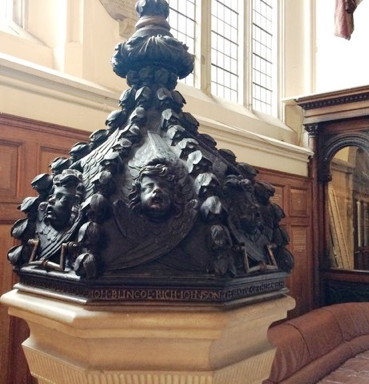Who was Jon Blincoe on the St Sepulchre Font?


-insert the strip photo and then the other of the font and somehow link like in the original ..
When visiting the famous St. Sepulchre church, Nicholas Blincoe noticed the name on this font and is wondering who Jon Blincoe might be? The earliest church on this site was built in the 1100s with additions during the later medieval period. The church was gutted by the Great Fire of London. This font cover was presented by the parishioners in 1670, the year the church reopened after the fire. This date gives a guide to who Jon/John might be.
There appear to be 3 names on the font cover including Jon Blincoe and Rich Johnson. The font has a finely carved octagonal cover. We are not totally sure which the Jon Blincoe is, as there are three possibilities, but suspect it to be the second Jon via a link to the Johnson name.
The first John Blinko was born in 1608 at St Brides Fleet Street and died about 1673: his wife Mary was buried in 1689 in Sepulchre. He was apprenticed to Giles Rowle, his stepfather, and was a skinner. It might be him but he is a bit too old.
The second John Blincoe, son of the above, was born in 1637 at Cripplegate and buried in 1697 at St Sepulchre. He married Sarah Eye. He was apprentice to Geo Johnson as an apothecary He is shown as being assessed in 1694 for the parish as John & wife Sarah Blencow. In the summer of 1695 the inhabitants of London were listed as part of the preparations for a new tax on births, marriages and deaths. The act imposing the Marriage Duty, as the tax has become known, was passed in April 1695 to help pursue the war against France with vigour and remained in force until 1706. It also imposed an annual payment by bachelors aged over 25 and childless widowers ranging from Dukes down to those with income under 50 per year. The St Sepulchre assessment is dated 24.7.1694. This means John and Sarah were quite well off and therefore more likely to be the Jon on the font. According to his will, John owned several properties in Chigwell, & Witham in Essex, Fulham and Mortlake in Surrey as well as Wood Street in London. John left considerable sums of money to his children. As the other name on the font — Richard Johnson was probably related to George Johnson, whom John was apprenticed to; I think this is the John of the Font.
The last John Blencoe was baptised in 1668 at St Sepulchre and buried there in 1728. He married Elizabeth Wilkins, daughter of Robert Wilkins and whose mother is probably Ellinor Blincoe. Again John was an apothecary & citizen of London apprenticed to his father and was the principal heir of his father. Like his father John lived in Hart Street so presumably the pharmacy was in Wood Street. By his age he could not have been the Jon on the Font.
St. Sepulchre's also has a significant role in the history of Newgate prison, as it was the nearest church to the prison. The clock was used to mark the time until executions. Frequently, the bellman of St. Sepulchres travelled under the gate to Newgate prison, to ring a bell, and give advice to the prisoners to be executed. He told them to repent, and prayed for their souls. The next morning, when the cart taking the prisoner to his execution passed by St. Sepulchre, the bellman would once again appear, toll the bells, and pray for the criminal. While there, the prisoners that were taken to Tyburn for execution were given a nosegay. This practice is believed to have originated as a way to show sympathy for those who would soon be leaving the world and its beauty.
There are many famous and infamous people buried or memorialised in and around the church.
The Royal Fusilier's Chapel which originally started as the City of London Regiment and later The Royal Fusilier's Regimental Chapel is where 12 Blencowes are named. The Regiment still hold their Remembrance Day service there.
With thanks to Roger Blinko who kindly provided the list shown below of Blencowes attached to the Regiment more details of these people can be found on his site.
Blencowe: Albert 1898 Brackley Private 45485, GS/84347
Blencowe: Charles Edward 1889 West Norwood London 2nd Lieutenant GS/13409, GS/13409
Blencowe: Francis Porter 1895 Whitehaven Lieutenant
Blencowe: Harry Francis 1893 Nr S. Stoneham Private GS/71155
Blencowe: Harry James 1891 Kidderminster Acting Sergeant/Private 31608, 9047, 579913
Blencowe: Oswald Charles 1890 Marston St Lawrence 2nd Lieutenant 14766/SE 29473
Blencowe: Walter Montague 1885 Sydenham .Corporal 39127, 61882 Royal Fusiliers
Blenko: Thomas Richard 1899 Herne Hill Private 23310, GS/76000
Blincko: Frederick William 1892 Lambeth Driver, Lance Corporal. 73048
Blinco: Arthur 1880 Little Swafftham Private 242871, GS/68011
Blincoe: Herbert 1889 Aston Birmingham Private 251891, 225318, 225318
Blincow: John MM 1890 Gartosh, Lanarkshire Private 4751, 111293, 383207
Lastly in the North Aisle is a war memorial of the sixth Battalion City of London Rifles known as the Cast Iron Sixth. On the North Wall is a rough wooden cross placed on the battlefield at Loos in 1915 where one hundred officers and men perished. It was later replaced with a permanent memorial.
Researched by Daphne Austin, UK